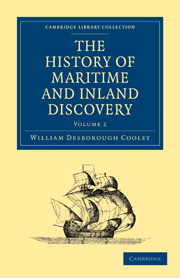Book contents
- Frontmatter
- Contents
- CHAP. I COLUMBUS
- CHAP. II COLUMBUS AND AMERIGO VESPUCCI
- CHAP. III EARLY DISCOVERIES IN AMERICA
- CHAP. IV SPANISH DISCOVERIES, AND FIRST CIRCUMNAVIGATION OF THE EARTH
- CHAP. V FERNANDO CORTEZ
- CHAP. VI CONQUEST OF PERU
- CHAP. VII CONQUESTS OF THE SPANIARDS
- CHAP. VIII CONQUESTS OF THE PORTUGUESE
- CHAP. IX FERDINAND MENDEZ PINTO
- CHAP. X VOYAGES TO THE NORTH
- CHAP. XI VOYAGES TO THE NORTH
- CHAP. XII VOYAGES TO THE NORTH
- CHAP. XIII SETTLEMENTS IN THE EAST
- CHAP. XIV SETTLEMENTS IN NORTH AMERICA
- CHAP. XV ESTABLISHMENTS IN AFRICA
- CHAP. XVI VOYAGES TO THE SOUTH SEA
- CHAP. XVII VOYAGES TO THE SOUTH SEA
- CHAP. XVIII VOYAGES IN THE PACIFIC, AND DISCOVERY OF AUSTRALIA
- CHAP. XIX EXPEDITIONS OF THE BUCCANEERS IN THE SOUTH SEAS
- CHAP. XX VOYAGES OF PRIVATEERS AND OTHERS TO THE SOUTH SEA
- CHAP. XXI DISCOVERIES OF THE RUSSIANS
- CHAP. XXII DISCOVERIES OF THE RUSSIANS
CHAP. XVII - VOYAGES TO THE SOUTH SEA
Published online by Cambridge University Press: 05 October 2010
- Frontmatter
- Contents
- CHAP. I COLUMBUS
- CHAP. II COLUMBUS AND AMERIGO VESPUCCI
- CHAP. III EARLY DISCOVERIES IN AMERICA
- CHAP. IV SPANISH DISCOVERIES, AND FIRST CIRCUMNAVIGATION OF THE EARTH
- CHAP. V FERNANDO CORTEZ
- CHAP. VI CONQUEST OF PERU
- CHAP. VII CONQUESTS OF THE SPANIARDS
- CHAP. VIII CONQUESTS OF THE PORTUGUESE
- CHAP. IX FERDINAND MENDEZ PINTO
- CHAP. X VOYAGES TO THE NORTH
- CHAP. XI VOYAGES TO THE NORTH
- CHAP. XII VOYAGES TO THE NORTH
- CHAP. XIII SETTLEMENTS IN THE EAST
- CHAP. XIV SETTLEMENTS IN NORTH AMERICA
- CHAP. XV ESTABLISHMENTS IN AFRICA
- CHAP. XVI VOYAGES TO THE SOUTH SEA
- CHAP. XVII VOYAGES TO THE SOUTH SEA
- CHAP. XVIII VOYAGES IN THE PACIFIC, AND DISCOVERY OF AUSTRALIA
- CHAP. XIX EXPEDITIONS OF THE BUCCANEERS IN THE SOUTH SEAS
- CHAP. XX VOYAGES OF PRIVATEERS AND OTHERS TO THE SOUTH SEA
- CHAP. XXI DISCOVERIES OF THE RUSSIANS
- CHAP. XXII DISCOVERIES OF THE RUSSIANS
Summary
Drake was the first Englishman who passed the Straits of Magellan, or who sailed under English colours in the Pacific Ocean. But independent of these strong claims to national celebrity, there are many circumstances in his voyage more intrinsically meritorious, and which demand, in a peculiar degree, the attention of the historian. It is remarkable that he should attempt, with so weak a fleet, to achieve a navigation long since abandoned by the Spaniards on account of its extreme difficulty and danger. He arrived in the tempestuous regions of the Magellanic Straits in the winter season, and yet he effected his passage through them in the short space of seventeen days; a much less time than was found necessary by any of those who preceded him, or even who followed him in that course.
It is likewise to be observed, that he advanced much farther towards the south than any of the Spanish discoverers. There is little room to doubt that he actually described the headland afterwards named Cape Horn. Had he himself written the narrative of his expedition, many proofs would unquestionably remain to us of a sagacious and penetrating spirit, which cannot be supplied from the vague and discordant narratives of his historians. He conjectured that the land to the south of the Straits of Magellan was broken land, or a cluster of islands; an observation repeated by subsequent voyagers, and which modern researches have gone near to verify.
- Type
- Chapter
- Information
- The History of Maritime and Inland Discovery , pp. 258 - 278Publisher: Cambridge University PressPrint publication year: 2010First published in: 1830



